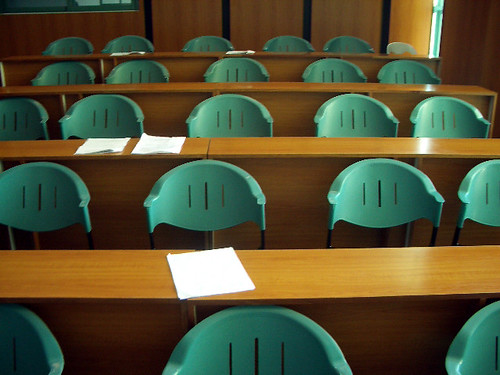As professors, we’ve all seen the problem of underperforming students in our classes -- students who could do well cognitively and behaviorally but do not for a variety of reasons. We know the phenomenon of high D/W/F courses, especially those in math and science, where large numbers of students fail to meet requirements.
 In a 2009 article on concept mapping, Kyo You Lim, Hyeon Woo Lee, and Barbara Grabowski (British Journal of Educational Technology), say that college students are required to process a great deal of information, but simple access to this information doesn’t guarantee the creation of knowledge. Barry Zimmerman, who has written widely on self-regulated learning, wrote in 2002 in Becoming a Self-Regulated Learner: An Overview (Theory in Practice) that few teachers actually prepare students to learn on their own.
In a 2009 article on concept mapping, Kyo You Lim, Hyeon Woo Lee, and Barbara Grabowski (British Journal of Educational Technology), say that college students are required to process a great deal of information, but simple access to this information doesn’t guarantee the creation of knowledge. Barry Zimmerman, who has written widely on self-regulated learning, wrote in 2002 in Becoming a Self-Regulated Learner: An Overview (Theory in Practice) that few teachers actually prepare students to learn on their own. Self-Regulated Learning
One solution to this age-old problem is Zimmerman’s work on self-regulated learning (SRL). Anthony Artino and Jason Stephens, writing in an article about adaptive and self-regulated learning in the summer of 2009 issue of the Journal of Advanced Academics, say that theories of SRL are used by educators and educational psychologists to better understand how successful students work and how they improve their learning. These authors call SRL “Academic Self Regulated Learning”, saying that self-regulated learners are active participants who efficiently control thoughts, feelings, and actions to improve learning.
Zimmerman (2002) states that SRL is self-generated thoughts, feelings, and behaviors that are oriented to attaining goals. SRL involves more than knowledge of a skill; it involves self-awareness, self-motivation, and behavioral skills to implement learning appropriately. Joanna Garner of Penn State University, writing in a 2009 issue of the Journal of Psychology, compared executive functions of planning, impulse control, goal setting, self-monitoring, and motivational drive and found that when intact, these executive functions predicted cognitive strategy use, metacognition, and academic effort regulation – all tenets of SRL (Conceptualizing the Relations Between Executive Functions and Self-Regulated Learning). Garner visually described SRL this way:
Garner believed that self-regulation consisted of metacognitive strategies that lead to academic effort, and more affective elements that lead to motivation and volition to succeed. Yet Zimmerman (2002) says that SRL is not a mental ability or an academic skill; instead it is a self-directive process by which learners transform their mental abilities into academic skills. Zimmerman lists three phases of SRL:
1. Forethought phase – where our interests lie
2. Performance control – where we apply cognitive and learning strategies
3. Self-Reflective – where we assign cause and effect to our actions
Zimmerman believes that these phases are what we all go through as we identify our interests, manage our cognitive efforts to learn, and identify causes for our actions.
Applying SRL In the Classroom
Theories are sometimes hard to apply in the classroom. Zimmerman and colleagues conducted an experiment in 2010 to investigate a semester-long classroom intervention designed to enhance SRL processes in at-risk math undergraduate students ((Zimmerman, Moylan, Hudesman, & Flugman, Overcoming self-regulatory deficits of at-risk math students at an urban technical college: A self-regulated learning intervention. Presented at the 2010 Research Conference of the Institute of Education Sciences). After the intervention, significantly more students in the SRL treatment groups passed the math course than did those in the control groups. Three interventions were used:
1. Instructor modeling of error correction
2. Guided self-reflection opportunities as part of formative assessment
3. Incentive system to reward subsequent attempts at learning
Here’s how Zimmerman and his colleagues implemented SRL processes in the at-risk students. First, the teachers purposely made errors in their content presentation and then modeled techniques to solve problems. Students were encouraged to come to the board and talk aloud their solutions – verbalizing the problems, their detection of the errors, and the way to solve them.
Every 3-4 days the students took a 4-5 question quiz. Before answering each question, students estimated their confidence (their self-efficacy) in solving the problem..
 They solved the problem, then estimated their confidence that they had solved it correctly (their self judgement).
They solved the problem, then estimated their confidence that they had solved it correctly (their self judgement).The quizzes were returned along with a self-reflection form; on it, students could explain what they did wrong and needed to do to solve the problem correctly; then if they solved a similar problem correctly, they were given partial credit for the quiz (called incentive points). They also compared their self-efficacy and self-judgement scores on the basis of how they solved the problem. Questions were discussed in groups, and students practiced describing math strategies and procedures.The experiment was successful in proving that equipping students with SRL processes will help them succeed.
Not all of us can go to the depth of intervention that Zimmerman's experiment did, but we can implement methods to better equip students with SRL processes. We can expand the amount of reflection that students do; we can let them estimate their readiness for tests and other academic challenges, and we can use class time to collaboratively explore areas that are difficult. We can remind students to plan, organize, and manage their study efforts; we can explicitly model learning strategies that will help them succeed, and we can allow them to redouble their efforts to understand why they failed to succeed. Self-regulated learning may not be a single skill, but it is teachable, and it is worth trying.

No comments:
Post a Comment